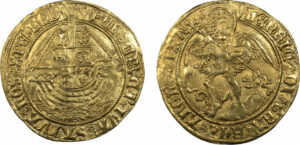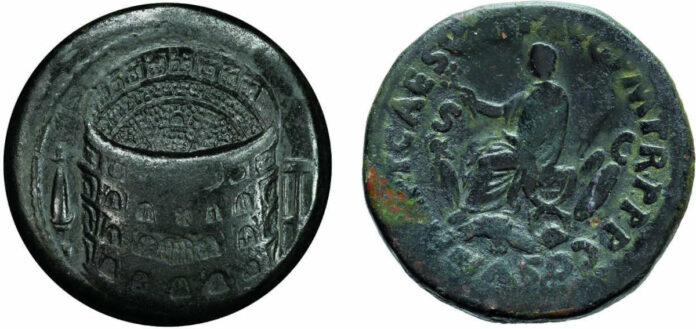Harlan J. Berk’s 221st Buy or Bid Sale
Harlan J. Berk, Ltd. has just launched sale 221 on their web site with paper catalogs following in a few weeks. This catalog has a large amount of affordable lots along with a few fantastic highlights worth noting. The entire sale consists of 580 ancient coins, 53 world coins & 86 antiquities to choose from. Highlights are as follow:
- Lot 3: Zeugitania, Carthage Gold Trihemistater, dated c. 264-260 BC. This coin is published in Jenkins, Ex Catherine E. Bullowa/Coinhunter, with original ticket. Ex R. B. Lewis Collection. Ex 1948 Tunis Hoard (ICGH 2271). This is a magnificent example of one of the most beautiful gold coins struck by Carthage. It is rare to get a plate coin from Jenkins Volume on this series. This was also, for a number of years, in the private collection of Catherine Bullowa, a famous dealer for many decades, of extraordinary taste, and we are told this coin was one of her favorites. Utterly magnificent!

- Lot 42: Sicily, Katane Silver Tetradrachm by Euainetos; c. 408/7 BC. This coin from Katane is one of the absolute highlights of Greek artistry. It is signed by the artist Euainetos. The head of Apollo (or Amenanos, the river-boy), though male, appears to the viewer to be that of a beautiful, attractive woman. He has delicate features and the hair is thrown up high with mounds of curls. Charles Seltman in his Masterpieces of Greek Coinage comments on how the coin of Catane and the Syracusean tetradrachm shown opposite in his book are so similar in appearance that they must be brother and sister. Percy Gardner in his article in the NC from 1876 sums it up quite beautifully when he says “…the distinguishing mark of which is delicacy and extreme refinement passing into luxuriousness. The fastidiousness of the lips and the great delicacy of the nose will be especially striking if we compare this representation with the last but one (No. 24 is a full-frontal view of Apollo, which is considerably less refined than our coin). The length of the hair and its confinement at the back show a return to archaistic treatment.” Ex Gemini X, 13 January 2013, lot 12. Ex Hirsch 275, 22 September 2011, lot 3210. Ex M&M Basel 72, 6 October 1987, lot 515
- Lot 50: Sicily, Syracuse Silver Tetradrachm; c. 405-395 BC. Arethusa Underwater. This is a famous issue, related to the fact that Syracuse was originally on an island. This is the only issue which reflects this. Arethusa’s hair very beautifully floats up behind her head, moving very slightly back with the current of the sea. Die were one by Eukleidas, and while there are many die of equal quality, very few, perhaps only one in ten, are actually signed. This coin is exceptional in that all of the hair is visible; very frequently, due to centering issues, the hair is struck off-flan, and thus not apparent to the viewer.
- Lot 103: Silver Shekel of Tyre; Crucifixion Date Finest Known; Year 159=33/4 CE. For an issue this common, we rarely, if ever, make the statement that the coin is the finest-known. But this coin is so utterly flawless, and so uncirculated, that there can be nothing finer. The small flan reflects the fact that Herod had contracted with Tyre to mint smaller coins of the same weight. Each half-shekel represented the tax paid by Jewish for the upkeep of the temple.
- Lot 415: Augustus and Agrippa Bronze Dupondius; Nemausus, c. 10-14 AD. Many years ago, this coin and another like it came to market. They are massively better than anything else that exists.

- Lot 423: Titus Colosseum Bronze Sestertius; c. 80-81 AD. This is a wonderful Colosseum sestertius that we handled originally a number of years ago. It is in wonderful condition; even though it has some obvious wear, especially on the reverse, it has no corrosion, pitting or tooling whatsoever. You can clearly see images of the Romans inside the Colosseum, the construction of which, according to a recently discovered dedicatory inscription, was paid for with treasure taken from the Jewish temple when they were defeated in the first revolt. This is the most desirable bronze in the entire Roman series. A prize for any collection. Ex Gemini XIII, 6 April 2017, lot 162. From a British collection, acquired in 1978 by Paul Munro Walker.

- Lot 586: Great Britain, George II, 1727-60, 1739 Gold 2 Guineas, NGC AU58, Sharp, fresh original coin with a provenance dating back to 1916. Ex B. Max Mehl, lot 477, 11/7/1916 (envelope included).

- Lot 587: Great Britain, Henry VII, 1485-1509, ND Angel, EF/AU, ND (1505-09). London Mint; mm: pheon. S-2187; Fr-151; N-1698. 5.2g, 28.3mm. St. Michael standing facing, head right, spearing dragon to lower right with spear topped by cross crosslet/Ship bearing shield and cross; ? and rose flanking cross. Lovely strike and pretty golden hue with old Max Mehl ticket lot 431 from an auction dated Wednesday, December 12, 1917 where it sold for $8.00!
View all lots offered in the online catalog.
For further information, visit the Harlan J. Berk website.



